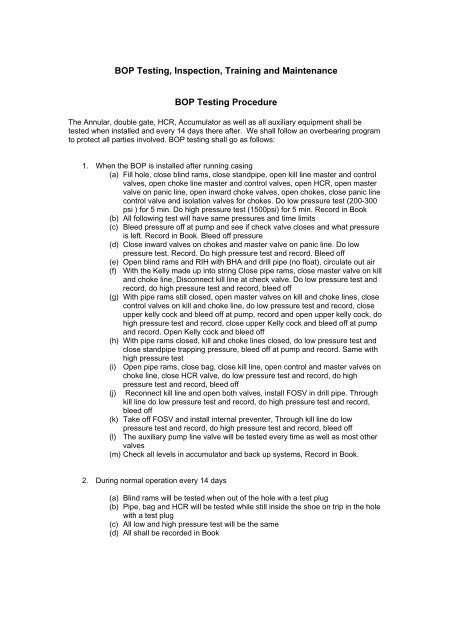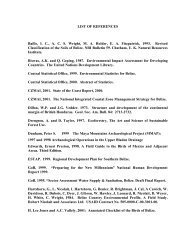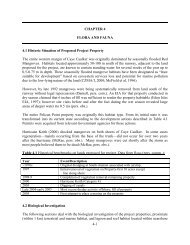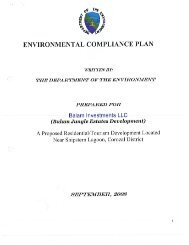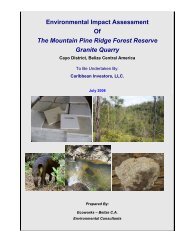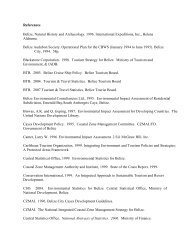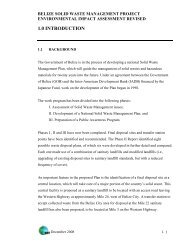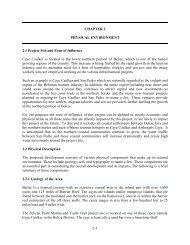BOP Testing, Inspection, Training and Maintenance
BOP Testing, Inspection, Training and Maintenance
BOP Testing, Inspection, Training and Maintenance
Create successful ePaper yourself
Turn your PDF publications into a flip-book with our unique Google optimized e-Paper software.
<strong>BOP</strong> <strong>Testing</strong>, <strong>Inspection</strong>, <strong>Training</strong> <strong>and</strong> <strong>Maintenance</strong><br />
<strong>BOP</strong> <strong>Testing</strong> Procedure<br />
The Annular, double gate, HCR, Accumulator as well as all auxiliary equipment shall be<br />
tested when installed <strong>and</strong> every 14 days there after. We shall follow an overbearing program<br />
to protect all parties involved. <strong>BOP</strong> testing shall go as follows:<br />
1. When the <strong>BOP</strong> is installed after running casing<br />
(a) Fill hole, close blind rams, close st<strong>and</strong>pipe, open kill line master <strong>and</strong> control<br />
valves, open choke line master <strong>and</strong> control valves, open HCR, open master<br />
valve on panic line, open inward choke valves, open chokes, close panic line<br />
control valve <strong>and</strong> isolation valves for chokes. Do low pressure test (200-300<br />
psi ) for 5 min. Do high pressure test (1500psi) for 5 min. Record in Book<br />
(b) All following test will have same pressures <strong>and</strong> time limits<br />
(c) Bleed pressure off at pump <strong>and</strong> see if check valve closes <strong>and</strong> what pressure<br />
is left. Record in Book. Bleed off pressure<br />
(d) Close inward valves on chokes <strong>and</strong> master valve on panic line. Do low<br />
pressure test. Record. Do high pressure test <strong>and</strong> record. Bleed off<br />
(e) Open blind rams <strong>and</strong> RIH with BHA <strong>and</strong> drill pipe (no float), circulate out air<br />
(f) With the Kelly made up into string Close pipe rams, close master valve on kill<br />
<strong>and</strong> choke line, Disconnect kill line at check valve. Do low pressure test <strong>and</strong><br />
record, do high pressure test <strong>and</strong> record, bleed off<br />
(g) With pipe rams still closed, open master valves on kill <strong>and</strong> choke lines, close<br />
control valves on kill <strong>and</strong> choke line, do low pressure test <strong>and</strong> record, close<br />
upper kelly cock <strong>and</strong> bleed off at pump, record <strong>and</strong> open upper kelly cock, do<br />
high pressure test <strong>and</strong> record, close upper Kelly cock <strong>and</strong> bleed off at pump<br />
<strong>and</strong> record. Open Kelly cock <strong>and</strong> bleed off<br />
(h) With pipe rams closed, kill <strong>and</strong> choke lines closed, do low pressure test <strong>and</strong><br />
close st<strong>and</strong>pipe trapping pressure, bleed off at pump <strong>and</strong> record. Same with<br />
high pressure test<br />
(i) Open pipe rams, close bag, close kill line, open control <strong>and</strong> master valves on<br />
choke line, close HCR valve, do low pressure test <strong>and</strong> record, do high<br />
pressure test <strong>and</strong> record, bleed off<br />
(j) Reconnect kill line <strong>and</strong> open both valves, install FOSV in drill pipe. Through<br />
kill line do low pressure test <strong>and</strong> record, do high pressure test <strong>and</strong> record,<br />
bleed off<br />
(k) Take off FOSV <strong>and</strong> install internal preventer, Through kill line do low<br />
pressure test <strong>and</strong> record, do high pressure test <strong>and</strong> record, bleed off<br />
(l) The auxiliary pump line valve will be tested every time as well as most other<br />
valves<br />
(m) Check all levels in accumulator <strong>and</strong> back up systems, Record in Book.<br />
2. During normal operation every 14 days<br />
(a) Blind rams will be tested when out of the hole with a test plug<br />
(b) Pipe, bag <strong>and</strong> HCR will be tested while still inside the shoe on trip in the hole<br />
with a test plug<br />
(c) All low <strong>and</strong> high pressure test will be the same<br />
(d) All shall be recorded in Book
<strong>BOP</strong> <strong>Inspection</strong> <strong>and</strong> Actuation<br />
All required <strong>BOP</strong> equipment shall be actuated periodically to ensure operational readiness.<br />
Following are the minimum frequencies.<br />
1. Every 12 hour shift the following are to be performed:<br />
(a) Check the accumulator pressure<br />
(b) Check the pressure of the emergency back-up system<br />
(c) Check the hydraulic fluid level in the accumulator<br />
(d) Check air pressure to support system<br />
(e) Record all of the above in IADC Log Book <strong>and</strong> well Ledger<br />
2. Every trip, but do not do twice in 24 hours<br />
(a) Function test pipe rams (when inside shoe)<br />
(b) Function test blind rams(when out of hole)<br />
(c) Operate all Kelly cocks<br />
(d) Check Drill pipe safety valve<br />
(e) Function test HCR valve<br />
(f) Record all of the above in IADC Log Book <strong>and</strong> well Ledger<br />
3. Every 7 days or 1 week actuate the following:<br />
(a) Annular preventer<br />
(b) All gate valves in the choke <strong>and</strong> kill system<br />
(c) Inside <strong>BOP</strong><br />
(d) Record all of the above in IADC Log Book <strong>and</strong> well Ledger<br />
Crew <strong>Training</strong> <strong>and</strong> Drills<br />
<strong>BOP</strong> Practice drills <strong>and</strong> training sessions shall be conducted at least once each week for each<br />
crew. These drills shall be performed with everyone on site to provide training for each crew<br />
member to ensure:<br />
1. A clear underst<strong>and</strong>ing of the purpose <strong>and</strong> the method of operation of each preventer<br />
<strong>and</strong> all associated equipment<br />
2. The ability to recognize the warning signs that accompany a kick<br />
3. The crew shall be aware this is a shallow slim hole which reduces volume in the<br />
annulus <strong>and</strong> requires increased attention<br />
4. A clear underst<strong>and</strong>ing of each crew members station <strong>and</strong> duties in the event of a kick<br />
while drilling, tripping or out of the hole<br />
5. A clear underst<strong>and</strong>ing of the maximum allowable casing pressure (MACP) <strong>and</strong> the<br />
significance of the pressure for well conditions that exist at the time of the drill or<br />
training session
<strong>BOP</strong> Records Requirements<br />
1. A record of all inspections <strong>and</strong> tests must be recorded in IADC Log book <strong>and</strong> well<br />
ledger<br />
2. A record of all crew drills <strong>and</strong> training sessions must be kept in the IADC Log book<br />
<strong>and</strong> well ledger<br />
<strong>BOP</strong> <strong>Maintenance</strong> Requirements<br />
1. All equipment shall be maintained in accordance with the manufacturer’s<br />
recommendations<br />
2. All maintenance records shall be kept for the past three years<br />
Shut-In Procedure Drilling <strong>and</strong> Tripping<br />
Drilling<br />
1. For a kick while drilling stop the rotary <strong>and</strong> sound the alarm<br />
2. Pick up drill string until the Kelly saver sub clears the rotary table<br />
3. Stop the pumps<br />
4. Close the annular preventer<br />
5. Confirm that all flow from the well is stopped. No flow should occur from the choke<br />
manifold, the bell nipple or back through the drill string<br />
6. Open the HCR valve<br />
7. Read <strong>and</strong> record SIDPP (shut in drill pipe pressure) SICP (shut in casing pressure)<br />
Allow to stabilize first<br />
8. Read <strong>and</strong> record the pit level increase<br />
9. Notify Supervisor<br />
The primary advantage of a hard shut-in is that the kick influx is held to a small volume<br />
because the well is closed in more quickly.<br />
Tripping<br />
1. For a kick while tripping immediately .set the slips <strong>and</strong> sound the alarm<br />
2. Install <strong>and</strong> make up the FOSV in the drill pipe. It should be open<br />
3. Close the drill pipe safety valve<br />
4. Open the HCR valve<br />
5. Close the <strong>BOP</strong><br />
6. Close the choke<br />
7. Confirm that all flow from the well has stopped<br />
8. Pick up <strong>and</strong> make up the Kelly<br />
9. Record SIDPP <strong>and</strong> SICP<br />
10. Read <strong>and</strong> record pit level increase<br />
11. Notify Supervisor


